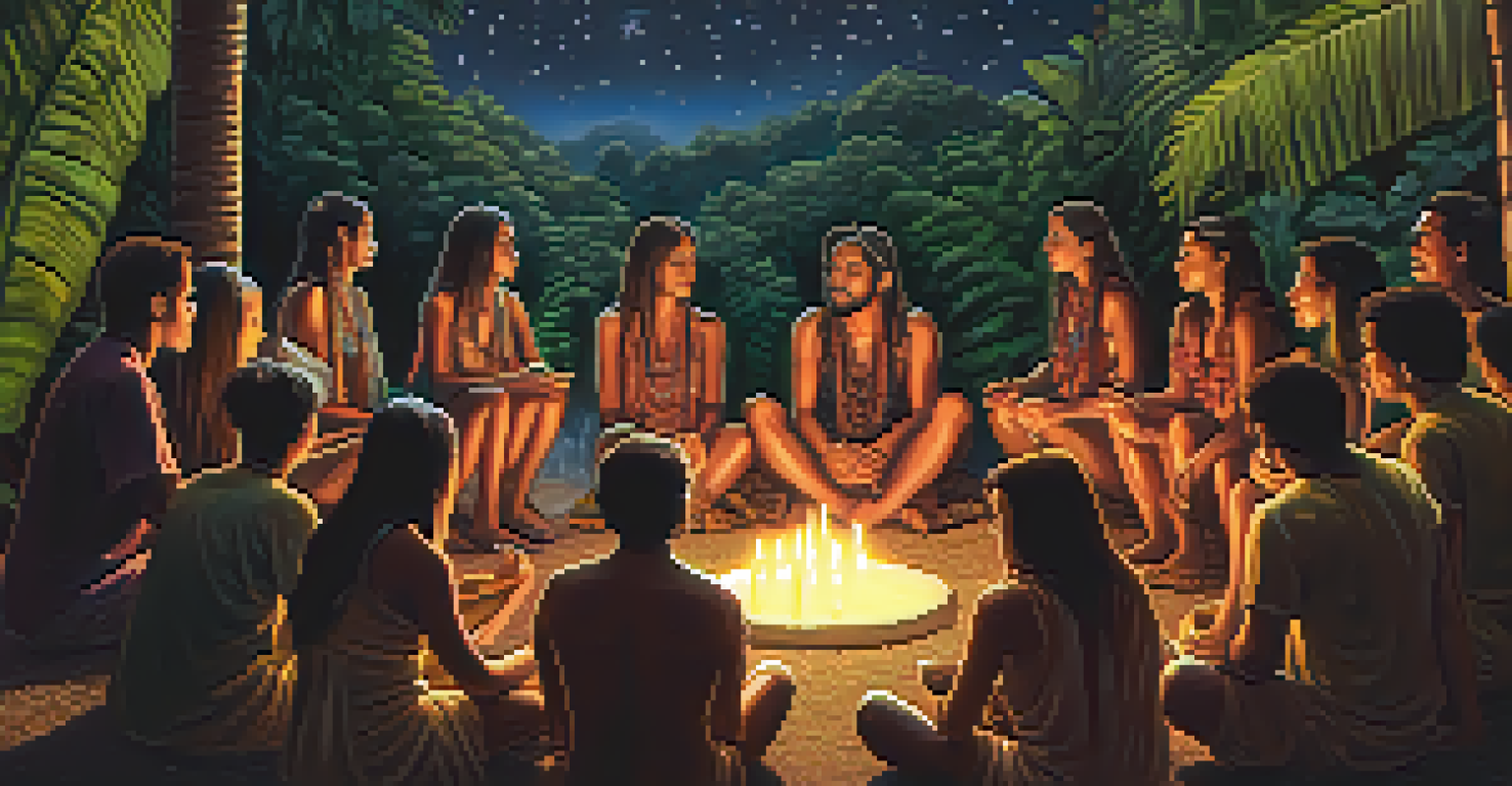Ayahuasca Retreats: Catalysts for Lasting Personal Change

Understanding Ayahuasca: A Brief Overview
Ayahuasca is a traditional Amazonian brew made from two plants, the Banisteriopsis caapi vine and the Psychotria viridis leaf. This powerful concoction contains DMT, a potent psychedelic compound, which has been used for centuries in shamanic rituals. Participants often seek ayahuasca for spiritual exploration and healing, experiencing deep introspection and connection to nature.
The greatest discovery of my generation is that a human being can alter his life by altering his attitude of mind.
Retreats dedicated to ayahuasca provide a safe and guided environment where individuals can participate in ceremonies led by experienced shamans. These retreats typically take place in serene, natural settings, enhancing the overall experience. Many attendees report profound insights and emotional releases during their time with ayahuasca, leading to transformative personal change.
The rituals surrounding ayahuasca are steeped in tradition, often incorporating music, chanting, and meditation. This holistic approach supports the healing process, allowing participants to integrate their experiences more fully. In this way, ayahuasca retreats serve not just as a means of exploration but as a pathway to deeper self-awareness.
The Role of Set and Setting in Healing
Set and setting refer to the mindset of the participant and the physical environment in which the experience occurs. A supportive and nurturing environment can significantly enhance the healing potential of ayahuasca. This is why retreats often emphasize creating a safe space, fostering trust between participants and facilitators.

At a retreat, attendees are typically surrounded by nature, which can amplify feelings of peace and connectedness. The presence of like-minded individuals also contributes to a sense of community, helping participants feel less isolated during their journeys. This shared experience can lead to deeper bonds and collective healing.
Ayahuasca as a Healing Tool
Ayahuasca is used for emotional healing and spiritual exploration, with many participants reporting transformative insights during retreats.
Moreover, the preparation leading up to the ceremony is crucial. Participants often engage in dietary restrictions and mindfulness practices, which help clear the mind and body, setting the stage for a more profound experience. This intentional approach underscores the importance of both mental and physical readiness for the journey ahead.
Ayahuasca and Emotional Healing: A Deep Dive
Many individuals turn to ayahuasca retreats seeking emotional healing, particularly from trauma or grief. The intense introspection facilitated by the brew can help participants confront suppressed emotions. This process often leads to catharsis, allowing for the release of long-held pain and resentment.
Healing is not linear. It’s a spiraling journey that requires us to confront all parts of ourselves, even the painful ones.
During ceremonies, participants may experience vivid visions or memories, providing clarity on past events that shaped their lives. This insight can be both enlightening and challenging, but many find it crucial for moving forward. The emotional landscape explored during these experiences often fosters resilience and a renewed sense of purpose.
Furthermore, the integration of these experiences post-retreat is essential. Many retreats offer support groups or follow-up sessions to help participants process their journeys. This ongoing support reinforces the healing process, encouraging individuals to apply their newfound insights to everyday life.
Spiritual Awakening Through Ayahuasca Experiences
Ayahuasca is often viewed as a tool for spiritual awakening, allowing participants to connect with something greater than themselves. Many retreat attendees report experiences of unity with the universe or encounters with spiritual guides. This connection can instill a sense of purpose and belonging, often lacking in modern life.
The rituals associated with ayahuasca ceremonies often incorporate elements of spirituality, which can deepen the experience. Participants are encouraged to set intentions before the ceremony, guiding their journey toward specific spiritual insights. This intentionality can lead to profound revelations about one’s place in the world and the interconnectedness of all beings.
Importance of Set and Setting
The mindset of participants and the environment of the retreat play a crucial role in enhancing the healing potential of ayahuasca.
As individuals explore their spirituality, they often gain a clearer understanding of their values and priorities. This newfound clarity can inspire significant changes in lifestyle and relationships, as participants align their actions with their core beliefs. The transformative power of ayahuasca can lead to a more fulfilling and purpose-driven life.
Integration: Making Sense of the Experience
Integration is a critical aspect of the ayahuasca journey, allowing participants to process and incorporate their experiences into daily life. After the retreat, many individuals face the challenge of translating their insights into actionable changes. Support systems, such as therapy or peer groups, can be invaluable during this time.
During integration, individuals reflect on their experiences, often journaling or discussing them with others. This practice allows them to identify patterns, lessons, and areas for growth. By sharing their stories, participants not only solidify their understanding but also inspire others on similar journeys.
Additionally, maintaining mindfulness and self-care practices post-retreat can help sustain the benefits of the experience. Whether through meditation, yoga, or nature walks, these practices encourage ongoing self-discovery and emotional health. Integration is not a one-time process; it’s an ongoing journey toward personal evolution.
Potential Challenges and Risks of Ayahuasca Retreats
While ayahuasca can be a powerful catalyst for change, it’s essential to acknowledge the potential challenges and risks involved. Not everyone will have a positive experience, and some may encounter difficult emotions or traumatic memories during their journey. It’s crucial for participants to approach the experience with caution and awareness.
Choosing the right retreat is vital to minimizing risks. Participants should research facilitators and ensure they are experienced and reputable. A supportive and safe environment can make a significant difference, so understanding the retreat's approach to care and integration is important.
Integration Post-Retreat Matters
Integrating experiences after an ayahuasca retreat is essential for personal growth, supported through reflection and community.
Moreover, individuals with certain health conditions or those on specific medications may face contraindications with ayahuasca. It's always advisable to consult with a healthcare professional before participating in a retreat. Being well-informed helps ensure that the journey is not only transformative but also safe.
Finding the Right Ayahuasca Retreat for You
When considering an ayahuasca retreat, finding the right one for your needs is crucial. Research is key—look for reviews, testimonials, and recommendations from previous attendees. Many retreats offer different focuses, from healing to spiritual growth, so it's important to align your intentions with the retreat's philosophy.
Consider the retreat’s location and setting as well. Some may prefer remote jungle retreats for an immersive experience, while others may opt for more accessible locations. The environment can significantly influence the retreat experience, so choose one that resonates with you.

Lastly, don’t hesitate to reach out to retreat organizers with questions. A reputable retreat will be transparent about their practices, facilitators, and safety measures. Taking the time to make an informed choice can enhance your overall experience and set the stage for meaningful personal change.